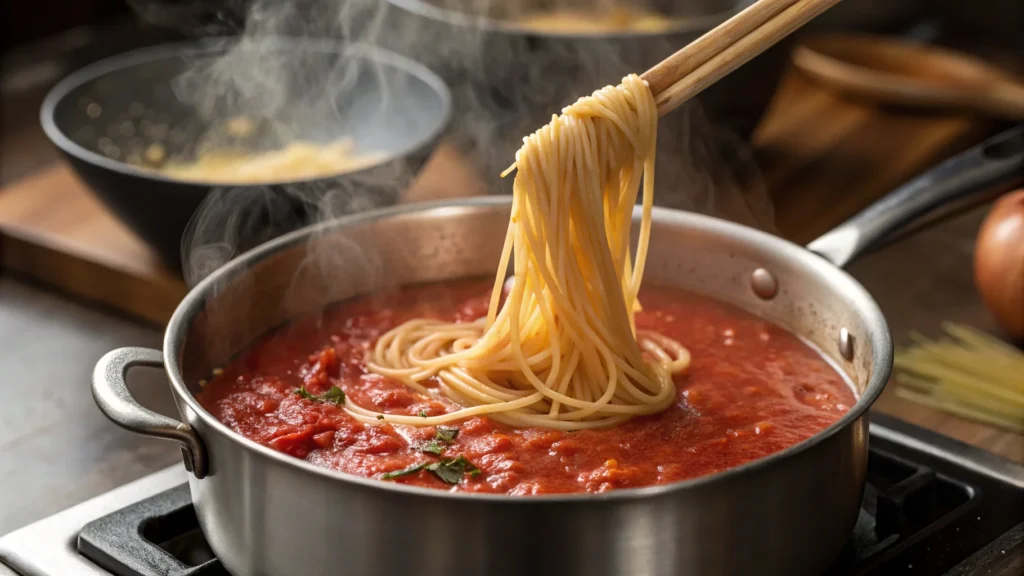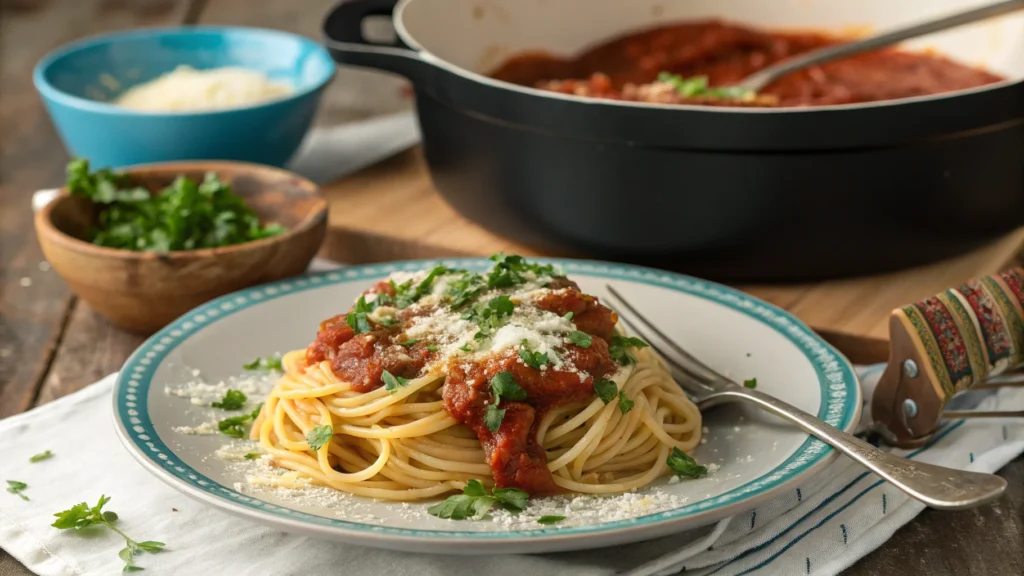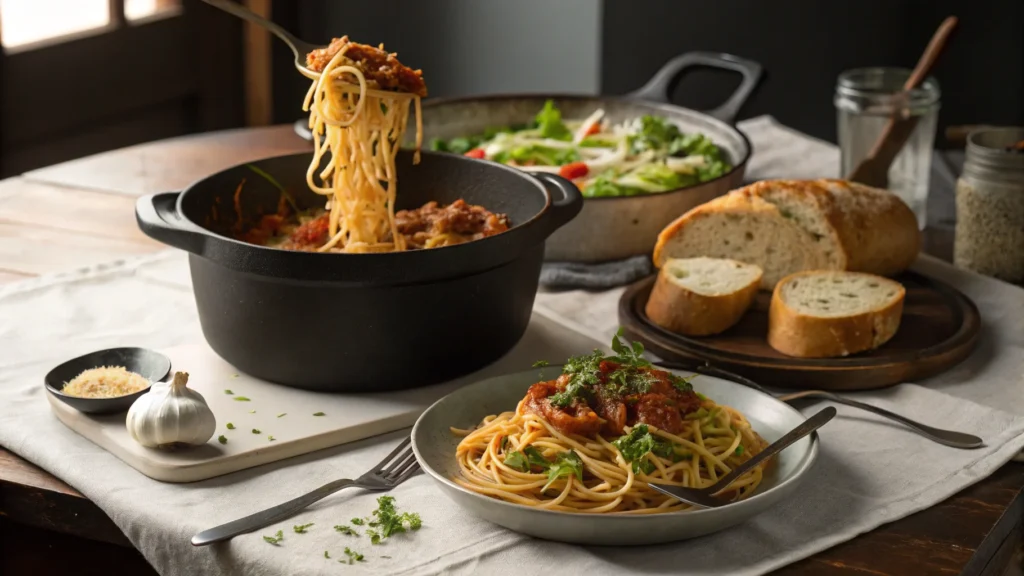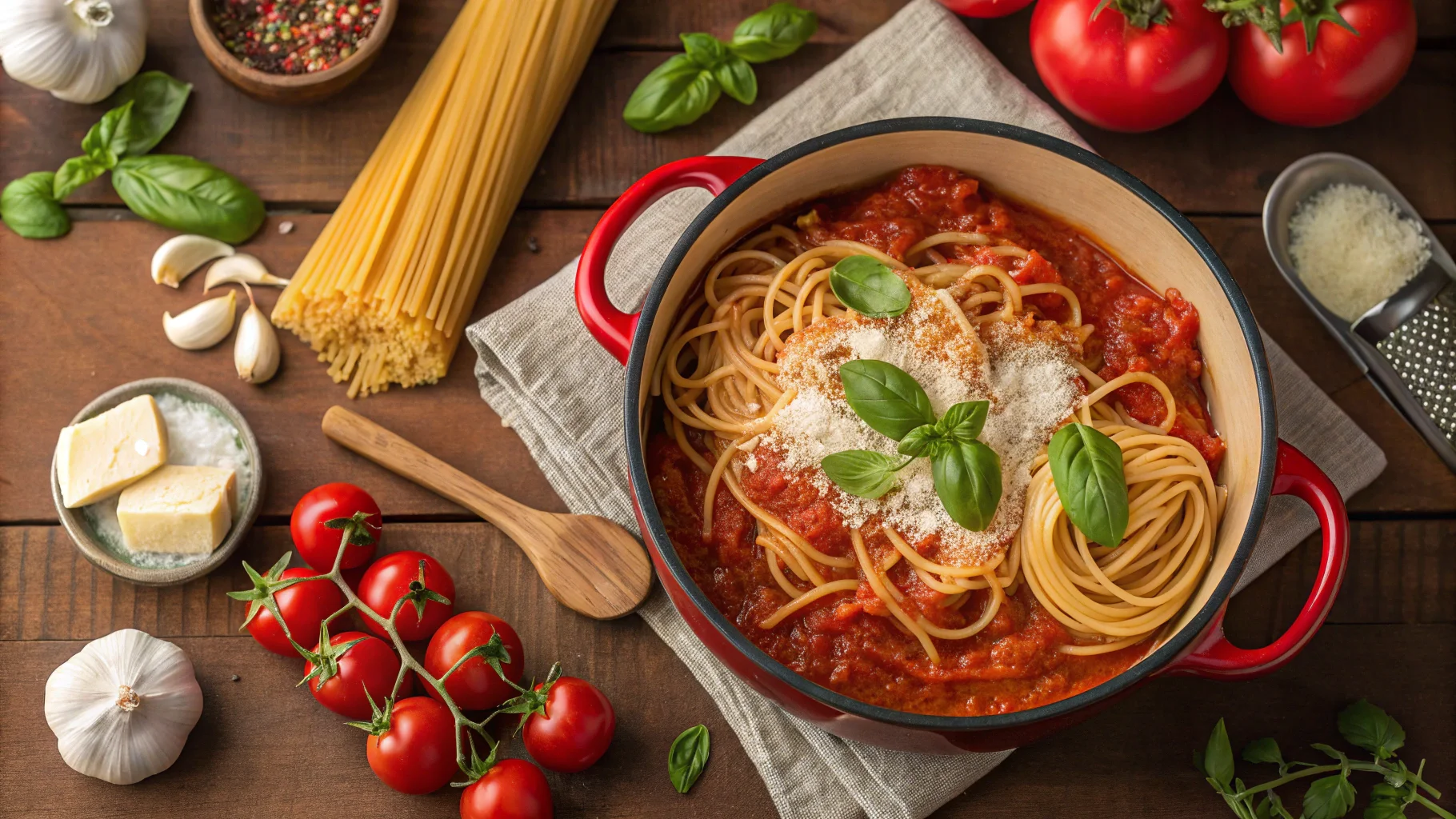Cooking spaghetti might seem like a straightforward task, but when you bring a Dutch oven into the mix, it opens up a whole new world of possibilities. Not only does it simplify the process, but it also enhances the flavors and makes cleanup a breeze. In this article, we’ll tackle the question “Can you use a Dutch oven for spaghetti?” and break down everything from the cookware’s benefits to troubleshooting common issues. Let’s dive in!
Table of contents
- What Makes a Dutch Oven Perfect for Spaghetti?
- Preparing to Cook Spaghetti in a Dutch Oven
- Step-by-Step Cooking Process
- Benefits of Cooking Spaghetti in a Dutch Oven
- Tips for Perfect Spaghetti in a Dutch Oven
- Common Mistakes to Avoid
- Alternative Recipes Using a Dutch Oven
- FAQs About Using a Dutch Oven for Spaghetti
- Wrapping Up: Why You Should Try This Method
- Conclusion
What Makes a Dutch Oven Perfect for Spaghetti?
The Versatility of a Dutch Oven
A Dutch oven is one of the most adaptable pieces of cookware you can own. Its thick, heavy walls retain heat exceptionally well, making it ideal for slow-cooked meals and one-pot dishes. This versatility shines when preparing spaghetti, as it allows you to cook everything—pasta, sauce, and toppings—in one pot.
Whether you’re whipping up a quick weeknight dinner or feeding a crowd, a Dutch oven can handle the job. From sautéing garlic and onions to simmering marinara sauce, it’s the ultimate all-in-one solution.
Even Heating for Better Cooking
One standout feature of Dutch ovens is their ability to distribute heat evenly. This ensures your spaghetti cooks perfectly, without clumping or sticking. Plus, the heavy lid traps steam, keeping the sauce moist and preventing it from drying out during cooking.
By using a Dutch oven, you not only save time and effort but also elevate the taste of your spaghetti. The question “Can you use a Dutch oven for spaghetti?” becomes a resounding yes when you see how well it performs.
Stay tuned for the next section, where we’ll discuss how to prepare for cooking spaghetti in your Dutch oven!

Preparing to Cook Spaghetti in a Dutch Oven
Choosing the Right Dutch Oven
When preparing to cook spaghetti, picking the right Dutch oven is key. A 5- to 7-quart Dutch oven is ideal for most recipes, as it provides enough space for your pasta, sauce, and stirring without spills. If you’re cooking for a crowd, opt for a larger size to ensure everything fits comfortably.
The type of Dutch oven matters, too. Enameled Dutch ovens are great for spaghetti because their smooth interior prevents sticking and makes cleanup a breeze. Cast iron versions without enamel are also effective, but they require proper seasoning to keep food from clinging to the surface.
Essential Ingredients for Success
To ensure your dish shines, gather high-quality ingredients. Start with dried spaghetti—whole wheat or gluten-free options work well, too. For the sauce, choose a rich marinara or a tomato-based sauce you love. Fresh garlic, onions, and herbs like basil or parsley can elevate the flavor even further.
And don’t forget the extras! Grated cheese, olive oil, or even roasted vegetables can make your Dutch oven spaghetti extra special. With everything ready, you’ll find the process seamless and enjoyable.
Step-by-Step Cooking Process
Browning and Building the Base
To create a flavorful base, heat a bit of olive oil in your Dutch oven over medium heat. Sauté minced garlic and diced onions until fragrant—this step infuses the dish with a savory aroma. Add your marinara sauce and stir well, letting it simmer for a few minutes to build richness.
Cooking Spaghetti in the Sauce
Here’s where the magic happens! Instead of boiling the pasta separately, add the uncooked spaghetti directly into the simmering sauce. If needed, break the pasta in half to fit it into the pot. Pour in enough water or broth to submerge the noodles, then stir to coat them evenly.
Cover the Dutch oven and let the spaghetti cook gently, stirring occasionally to prevent sticking. In about 10–12 minutes, your pasta will absorb the sauce and reach the perfect al dente texture.
With this method, you’ll save time, reduce cleanup, and enhance the flavor of your dish. Wondering “Can you use a Dutch oven for spaghetti?” The answer is clear: not only can you, but you absolutely should! Stay tuned for more tips and benefits in the next sections.
Benefits of Cooking Spaghetti in a Dutch Oven
One-Pot Convenience
Cooking spaghetti in a Dutch oven simplifies the entire process. With just one pot, you can sauté, simmer, and cook your pasta, eliminating the need for multiple pans. This saves you time on cleanup and streamlines your workflow in the kitchen.
Not only is it efficient, but one-pot cooking enhances the flavors of your dish. As the spaghetti cooks in the sauce, it absorbs the rich seasonings, resulting in a more cohesive and delicious meal.
Enhanced Flavor Profiles
A Dutch oven’s design contributes to better-tasting food. The even heat distribution ensures that your sauce simmers gently, reducing the risk of burning. The heavy lid traps moisture, which keeps your pasta tender and your sauce flavorful.
If you’ve ever wondered, “Can you use a Dutch oven for spaghetti?”, these benefits make it clear: it’s not only possible but also one of the best ways to elevate your cooking.

Tips for Perfect Spaghetti in a Dutch Oven
Preventing Sticking
One common concern when cooking spaghetti in one pot is sticking. To prevent this, stir the pasta frequently during the first few minutes of cooking. A small drizzle of olive oil in the sauce can also help keep the noodles separate.
Achieving the Right Sauce Consistency
As the pasta cooks, it absorbs liquid from the sauce. If the sauce becomes too thick, don’t hesitate to add small amounts of water or broth to reach the desired consistency. On the flip side, if the sauce is too thin, let the dish simmer uncovered for a few minutes to reduce and thicken.
With these simple adjustments, you can ensure that your spaghetti in a Dutch oven turns out perfectly every time. In the next sections, we’ll address common mistakes and offer solutions for flawless results.
Common Mistakes to Avoid
Overcooking the Pasta
One of the most common mistakes when preparing spaghetti in a Dutch oven is overcooking the pasta. Because the noodles cook directly in the sauce, it’s essential to monitor the timing closely. Start checking for doneness a couple of minutes before the package instructions suggest. Al dente pasta works best, as it continues to soften slightly after cooking.
If you accidentally overcook the spaghetti, don’t worry—reduce the liquid by simmering uncovered for a few minutes to help salvage the texture and flavor.
Using the Wrong Amount of Liquid
Another potential pitfall is adding too much or too little liquid. If the sauce is too watery, the flavors can become diluted. Conversely, too little liquid can lead to undercooked pasta or burning at the bottom of the pot.
To avoid this, add liquid incrementally and stir frequently. Remember, it’s easier to add more liquid than to take it away. These small adjustments ensure a perfectly balanced dish every time you ask yourself, “Can you use a Dutch oven for spaghetti?”
Alternative Recipes Using a Dutch Oven
One-Pot Pasta Variations
A Dutch oven isn’t just for spaghetti. This versatile cookware shines with other one-pot pasta dishes like creamy Alfredo, hearty penne with vegetables, or baked ziti. The method remains largely the same: combine the sauce and pasta in the pot, adjust the liquid, and cook to perfection.
Experimenting with different sauces and ingredients can keep your meals exciting and flavorful. You’ll quickly discover that a Dutch oven is one of the best tools for creative, easy-to-make pasta dishes.
Vegetarian and Gluten-Free Options
For those with dietary restrictions, a Dutch oven still works beautifully. Swap traditional spaghetti for gluten-free varieties or try zucchini noodles for a lower-carb option. To make it vegetarian, load your dish with roasted vegetables, spinach, or mushrooms for a hearty, satisfying meal.
By exploring these alternatives, you’ll see why the question “Can you use a Dutch oven for spaghetti?” is just the beginning of what’s possible. Next, we’ll tackle frequently asked questions and wrap up with tips for perfecting your dish!

FAQs About Using a Dutch Oven for Spaghetti
Can You Cook Spaghetti Without Boiling Water Separately?
Yes, you absolutely can! One of the best things about using a Dutch oven is that it allows you to cook your pasta directly in the sauce. This method saves time and enhances flavor as the spaghetti absorbs the sauce while it cooks. It’s a simple answer to the question “Can you use a Dutch oven for spaghetti?”
Does the Dutch Oven Work for Other Pasta Recipes?
Definitely! A Dutch oven is perfect for various pasta dishes, from creamy mac and cheese to hearty lasagna. Its even heating ensures consistent results, and its deep sides accommodate large portions, making it versatile for all your pasta cravings.
How Do You Prevent Sauce From Burning?
To prevent burning, keep the heat low to medium during cooking and stir frequently. Using an enameled Dutch oven also helps, as its smooth interior reduces the risk of sticking or scorching. Adding liquid, like water or broth, can keep the sauce at the right consistency as it simmers.
Can You Use a Non-Enamel Dutch Oven for Spaghetti?
Yes, you can, but you’ll need to ensure the pot is properly seasoned to prevent sticking. Enamel-coated Dutch ovens are often preferred for spaghetti due to their ease of use and quick cleanup, but traditional cast iron works well too with proper care.
Wrapping Up: Why You Should Try This Method
Cooking spaghetti in a Dutch oven is a game-changer for anyone seeking convenience, flavor, and simplicity in the kitchen. This method combines everything into one pot, reducing cleanup while maximizing taste. The even heating of a Dutch oven ensures perfectly cooked pasta and sauce every time, while its versatility allows for endless variations.
Whether you’re making a classic spaghetti dinner or experimenting with new pasta dishes, the Dutch oven proves to be an invaluable tool. So, the next time you ask yourself, “Can you use a Dutch oven for spaghetti?”, remember this: not only can you, but it’s the best way to elevate your cooking. Give it a try—you’ll wonder why you didn’t start sooner!
Conclusion
Using a Dutch oven for spaghetti is not just a convenient option—it’s a game-changer. This versatile cookware allows you to cook everything in one pot, enhancing flavors and saving time. From evenly cooked pasta to rich, simmering sauce, the Dutch oven brings out the best in every ingredient.
If you’re looking for more ways to elevate your cooking, check out this easy orange fish cookies recipe for a delightful side dish idea. Pair your pasta with a fresh cucumber salad with smoked salmon for a light, refreshing complement.
Whether you’re preparing a quick weeknight dinner or trying out new pasta variations, this method simplifies the process while delivering delicious results. So, the next time you’re in the kitchen, don’t hesitate to use your Dutch oven. It’s a reliable, versatile, and flavorful way to answer the question, “Can you use a Dutch oven for spaghetti?” Absolutely—you’ll love the results!

